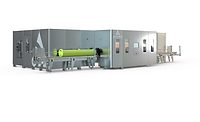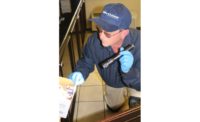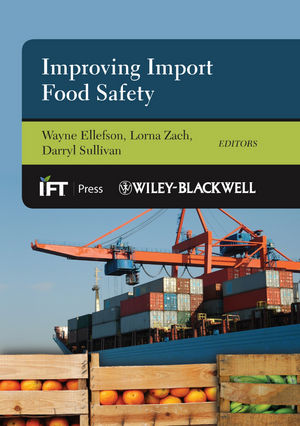Exclusive interview: Q&A with Hiperbaric on HPP

Food Safety Strategies was recently able to talk to Carole Tonello Samson, commercial & applications director, Hiperbaric, Burgos, Spain, about HPP (high-pressure processing).
Liz Parker: When and why did HPP start to become popular?
Carole Tonello Samson: While high-pressure processing traces its roots to the late 1800s, the first commercial HPP food products were launched in the 1990s. HPP didn’t start to become popular until 20 years ago with consumer demand for fresh foods with natural ingredients and no preservatives.
Guacamole initiated the growing popularity of HPP, followed by sliced deli meats, cold-pressed juices, salsa, seafood, baby food and pet food. Hiperbaric introduced the horizontal design of HPP machines, which remains the most popular design today.
HPP is a non-thermal form of pasteurization that inactivates foodborne and spoilage bacteria, with minimal impact on the taste, texture, appearance or nutritional value of food. It also extends shelf life from two to 10 times that of non-processed food, making it attractive for retailers.
Heat pasteurization cannot be used on fresh foods like cold-pressed juices and guacamole because it changes the organoleptic properties (look and taste). So HPP emerged as way to keep foods safe, while ensuring fresh taste and nutrition.
LP: How do your machines work to prevent foodborne pathogens, while keeping nutrients and flavor intact?
CTS: High pressure processing is a cold preservation technique which consists of subjecting food, previously sealed in flexible and water-resistant packaging, to a high level of hydrostatic water pressure (43,000-87,000 pounds per square inch). It extends shelf life without the need of preservatives while maintaining the sensorial and nutritional quality of the fresh product.
HPP disrupts several biochemical processes in microbial cells that leads to the inactivation of bacteria, yeasts, molds and some viruses. In general, bacteria, such as E. coli and Salmonella, are susceptible to the effects of high pressure.
The major benefits of HPP include:
- Destroys pathogens (e.g., E. coli, Listeria, Salmonella, Vibrio, Norovirus, and others), providing food safety.
- Maintains taste, appearance and nutrition of fresh foods, increasing food quality.
- Reduces drastically spoiling flora, resulting in extended shelf life, fewer product returns and customer satisfaction.
- Avoids or reduces the need for food preservatives, resulting in clean food labels.
- Provides innovation in food production, as products that cannot be thermally treated can now be high pressure processed, leading to more food choices and competitive advantages.
- Enables mollusk shucking or crustacean meat extraction without heat, resulting in higher yields, fresh flavor, and minimum manual labor.
- Only needs water (which is recycled) and electricity, making it environmentally friendly.
LP: Can you speak a bit about your new bulk technology for juices? How does this work?
CTS: The Hiperbaric Bulk machine is a global innovation for large productions of HPP beverages. The machine delivers up to 5,000 liters per hour, which is the world’s largest productivity, with the lowest processing cost and minimum energy consumption. The machine is designed to fit into any large beverage production line and will allow the use of any kind of packaging after HPP, no matter the material, design or size. With the new equipment, the process will be simpler, with fewer stages and with a higher productivity. Its design is based on one vessel of a Hiperbaric 525 machine, together with a system of tanks where beverage is stored before and after the HPP process.
Made for beverages and other low-viscosity liquid products, the Hiperbaric Bulk uses a large flexible pouch or bag to process up to about 500 liters (132 gallons) at a time. To inactivate the foodborne pathogens, the liquid is filled into this bag, which transmits the pressure to the beverage during the high pressure processing. After pressurizing, the liquid is sent through a high-pressure valve to an aseptic or ultraclean storage tank.
Hydrogen peroxide is used to sterilize the high-pressure valve and pipe connecting the processing chamber to the storage tank for each cycle. This is the same method and chemical used for sterilizing beverage containers. The sterilizable valve is unique to Hiperbaric, which is pursuing a patent.
The Bulk machine achieves twice the throughput of in-pack HPP treatment. This decreases energy costs per liter in half, and labor by 80 percent, since pouches or flexible bottles don’t need to be handled manually. The Hiperbaric Bulk technology also allows the use of glass or other rigid packaging, like carton bricks which is not an option for in-package HPP.
LP: Where do you see HPP going in the future?
CTS: I see more premium juices (processed in-bulk) plant-based dips, baby food and pet food being HPP processed.
Additionally, innovative products like plant-based, high-protein meals and functional foods and beverages such as vitamin-enhanced smoothies and beverages are also seeing growth.
Looking for a reprint of this article?
From high-res PDFs to custom plaques, order your copy today!








